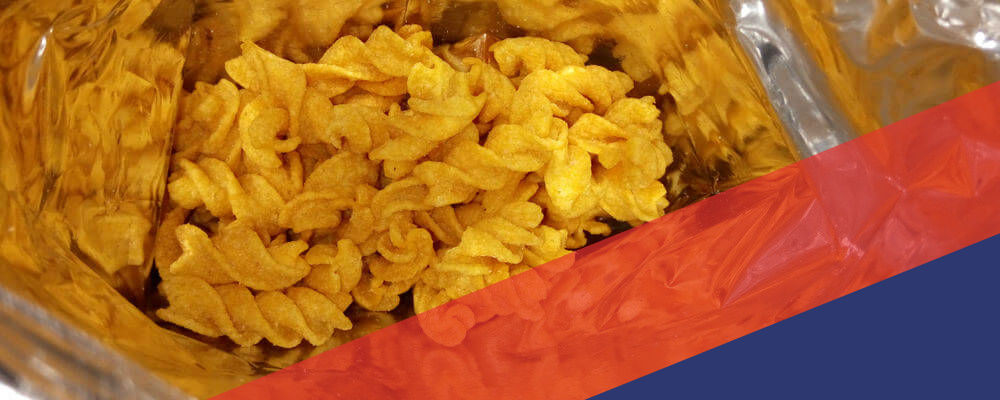Using Nitrogen Gas in Food Packaging – Why & How
August 31, 2020

One of the major challenges faced by food manufacturers is preserving the freshness of their products while prolonging shelf life. A failure to curb rapid food spoilage will result in a decline in income due to lower purchase rates for affected food materials.
The use of nitrogen in food packaging is one of the most effective ways of slowing food deterioration and improving longevity. This article will outline how food-grade nitrogen gas can be used to boost efficiency in the food and beverage processing industry.
What Is Gas Flushing for Food Packaging?
Gas flushing involves the use of a preservative gas to modify the environment within food packaging. Typically, inert gas packaging is done using nitrogen gas to achieve conditions suitable for longer food storage periods.
Gas flushing will displace oxygen and other contaminants from stored food packaging, minimizing oxidative reactions that encourage rapid food spoilage.
What Is Nitrogen Packaging?
Nitrogen packing requires the use of high concentrations of gaseous nitrogen within food packaging. Nitrogen at 99.0% concentration is usually recommended for food preservation. Other chemical conditions that contribute to effective nitrogen packaging are:
- Oxygen concentration should be maintained under 1%
- Carbon monoxide and carbon dioxide concentrations in the air mixture below 10ppm and 300ppm respectively.
- Moisture concentrations should remain below 55.8ppm
Why Nitrogen Is Used in Food Packaging

Gaseous nitrogen has unique chemical and physical properties that make it suitable for use in food processing. Nitrogen is inert which means it will not react with prepared food materials, which can alter their aromas or flavors. Also, gaseous nitrogen will effectively displace oxygen minimizing oxidation and the growth of microorganisms that cause foods to lose their freshness and deteriorate faster.
Is Nitrogen Flushing Bad for You?
When nitrogen gas is used in accordance with good manufacturing practice, the FDA considers it a GRAS ingredient, meaning nitrogen gas is “generally recognized as safe.”
How Does the Nitrogen Packaging System Work?
The nitrogen packaging system essentially involves replacing oxygen with nitrogen in food packing. To begin with, the food item to be preserved is placed in an unsealed wrapping or pack. Once this is done, food-grade nitrogen is introduced into the packing, driving out oxygen-rich air as well as any moisture present.
Sealing the food packing traps the nitrogen within it and ensures an oxidant poor environment that allows food materials to be stored longer.
How to Get Food-Grade Nitrogen Gas
High-quality nitrogen for food packaging can be obtained from one of two methods:
- Nitrogen gas cylinders regularly supplied to/stored at the food processing site
- Synthesis on demand using an on-site nitrogen generator
Nitrogen Gas Cylinders for Food Packaging
Nitrogen gas can be remotely synthesized and transported to a food processing plant when required. However, for a significant number of manufacturing processes, sourcing preservative gas using this method is not efficient.
The major drawbacks of using nitrogen cylinders for nitrogen-filled packaging include:
- Higher long term costs
- Safety hazards associated with gas cylinder storage and handling
- Consumption of vital floor space
- Disparities in supplied and useful gas volumes
Higher Long Term Costs
For food processing industries, the long term cost of purchasing nitrogen cylinders is significantly higher than the one time cost of purchasing a nitrogen generator even when combined with maintenance expenses. In addition to the cost of the gas itself, cylinder rentals and transportation will raise overall operation costs considerably.
Cylinder Storage and Handling Hazards
As with any gas storage units, there is a risk of accidental gas leakage when nitrogen cylinders are stored for long periods. While nitrogen gas is typically harmless in the open air, additional precautions must be taken to prevent a gas leak when nitrogen is stored in confined spaces. High concentrations of the gas pose a serious industrial hazard to any exposed personnel, and rigorous nitrogen gas safety procedures must be observed.
Consumption of Vital Floor Space
Large-scale food manufacturing processes require a greater volume of nitrogen which translates into a greater number of nitrogen gas cylinders. These gas storage units will take up a significant amount of industrial floor space which might have been dedicated to other critical process equipment.
Disparities in Supplied and Useful Gas Volumes
When using a gas cylinder as the source of nitrogen for food packing, gas shortages are inevitable. This is due to the design of the storage cylinders which makes it impossible to completely exhaust their contents. Consequently, the amount of nitrogen gas obtained is less than the volume supplied as all cylinders will retain a certain fraction of the gas even when “empty.”

On-Site Nitrogen Generators for Food Packaging
The most efficient method of generating the nitrogen required for food packaging is using dedicated PSA nitrogen generators or membrane nitrogen generators.
Using an on-site nitrogen generator for food packaging eliminates all the problems associated with the use of nitrogen gas cylinders. Nitrogen generators are ideal for medium to large scale food processing operations delivering high-purity nitrogen gas (99.0% or more).
GENERON Has On-Site Nitrogen Generators for Efficient Food Packaging
At GENERON, we are committed to providing our customers with the most efficient and cost-effective nitrogen generation solutions for their unique industrial processes.
Our nitrogen generators integrate state-of-the-art nitrogen membrane and adsorption technologies, which makes them uniquely suited to a broad range of industrial applications including food and beverage manufacture.
Contact GENERON online today for more information about our products and services.
